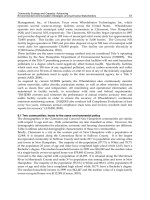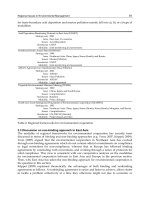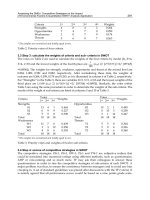CIM revision cards marketing management in practice by john williams
Bạn đang xem bản rút gọn của tài liệu. Xem và tải ngay bản đầy đủ của tài liệu tại đây (1.4 MB, 125 trang )
CIM REVISION CARDS
Marketing Management in Practice
John Williams
AMSTERDAM l BOSTON
PARIS l SAN DIEGO l
HEIDELBERG
SAN FRANCISCO
l
l
l
LONDON l
SINGAPORE
l
NEW YORK
SYDNEY
l
l
OXFORD
TOKYO
Elsevier Butterworth-Heinemann
Linacre House, Jordan Hill, Oxford OX2 8DP
30, Corporate Drive, Burlington, MA 01803
First published 2004
Copyright ß 2004, Elsevier Ltd. All rights reserved
No part of this publication may be reproduced in any material form (including photocopying or storing in any medium by electronic means
and whether or not transiently or incidentally to some other use of this publication) without the written permission of the copyright holder
except in accordance with the provisions of the Copyright, Designs and Patents Act 1988 or under the terms of a licence issued by the
Copyright Licensing Agency Ltd, 90 Tottenham Court Road, London, England W1T 4LP. Applications for the copyright holder’s written
permission to reproduce any part of this publication should be addressed to the publisher.
Permissions may be sought directly from Elsevier’s Science & Technology Rights Department in Oxford, UK: phone: (+44) 1865 843830,
fax: (+44) 1865 853333, e-mail: You may also complete your request on-line via the Elseiver homepage
(), by selecting ‘Customer Support’ and then ‘Obtaining Permissions’
British Library Cataloguing in Publication Data
A catalogue record for this book is available from the British Library
Library of Congress Cataloging in Publication Data
A catalogue record for this book is available from the Library of Congress
ISBN 07506 62883
For information on all Elsevier Butterworth-Heinemann publications visit our website at
Printed and bound in Great Britain
TABLE OF CONTENTS
1.
2.
3.
4.
5.
6.
7.
8.
9.
Preface ............................................................................. iv
Management and marketing roles.............................................. 1
Recruiting the team .............................................................. 17
Developing the team ............................................................. 34
Project management ............................................................. 54
Managing change................................................................. 64
Market research .................................................................. 68
Developing marketing plans ..................................................... 86
Marketing communications and customer service............................ 100
Bibliography ....................................................................... 117
PREFACE
Welcome to the CIM Revision Cards from Elsevier/Butterworth–Heinemann. We hope you will find these useful
when coming to revise for your CIM exam. The cards are designed to be used in conjunction with the CIM
Coursebooks from Elsevier/Butterworth–Heinemann, and have been written specifically with revision in mind.
They also serve as invaluable reviews of the complete modules, perfect for those studying via the assignment
route
n Learning outcomes at the start of each chapter identify the main points
n Key topics are summarized, helping you commit the information to memory quickly and easily
n Examination and revision tips are provided to give extra guidance when preparing for the exam
n Key diagrams are featured to aid the learning process
n The compact size ensures that the cards are easily transportable, so you can revise any time, anywhere
To get the most of your revision cards, try to look over them as frequently as you can when taking your CIM
course. When read alongside the Coursebook they serve as the ideal companion to the main text. Good luck –
we wish you every success with your CIM qualification!
PREFACE
v
Marketing Management in Practice
The module is assessed by either examination or an Integrated Project. The focus of the module is on:
n Teams
n
n
n
n
Working in marketing teams and with people in other functions.
International issues as part of everyday marketing life in organizations.
Managing and motivating people and teams to produce results.
Developing and managing teams to add value to the organization’s activities and deliver effective results.
n Effective team performance is contingent on a balance between the:
needs of the task
needs of the individuals within the team
maintenance needs of the team as a whole
n Integration and application of knowledge from all the Diploma modules.
n Applying the theory of market research, planning and communications from the previous modules.
n Developing and implementing the marketing plan by undertaking marketing activities and projects.
n Broad and practical demonstration of marketing at an operational level.
n Awareness of the strategic context.
n Basic project management techniques to help with managing the task.
This Page Intentionally Left Blank
MANAGEMENT AND
MARKETING ROLES
Syllabus Reference: 1.1, 1.2
n To describe the nature of relationships with other
functions in organizations operating in a range of
different industries and contexts (1.1)
n To explain the importance of developing and
maintaining effective relationships with people in
other functions and disciplines (1.2)
These particular learning objectives are a theme
throughout the book.
Unit 1
KEY DEFINITIONS
å Global firm – A firm that, by operating in more
than one country, gains R&D, production,
marketing and financial advantages in its costs
and reputation that are not available to purely
domestic competitors
å Global organization – A form of international
organization whereby top corporate
management and staff plan worldwide
manufacturing or operational facilities,
marketing policies, financial flows and
logistical systems. The global operating unit
reports directly to the chief executive, not to an
international divisional head
MARKETING MANAGEMENT IN PRACTICE
1
MANAGEMENT AND MARKETING ROLES
The Focus of the Module
n The module emphasizes the importance of
developing positive working relationships within
the marketing team and with external agents and
internal organizational functions via effective
communication and effective management of
quality and customer care
n You need to show awareness of the challenges
that marketing teams face operating in a global
context
n The need for appropriate research to inform the
planning process
n Developing effective communication strategies so
that people have the right information to complete
the task is important
2
n Selecting the right people for the right team by
identifying knowledge, skills and other essential
attributes required
n Building strong marketing teams through flexible
and adaptable leadership
n Motivating teams and individuals to raise their
performance by recognizing and rewarding
achievement
n The importance of planning for operational
marketing, including auditing, setting objectives,
scheduling, resourcing, implementing and
evaluating the plan
n The need to communicate effectively as a team
when working together on projects and to develop
a communication strategy for the marketing plan.
n Using the combined knowledge and skills within
marketing teams to implement marketing plans
Marketing Orientation
n A marketing oriented company needs to align its
distinctive competencies with market
opportunities, but to do this effectively requires
a team effort
n Customer focus needs to be shared by the whole
organisation and not seen as the responsibility of
only the marketing department or marketing
person in isolation
n A key element of market orientation is
intelligence-gathering about customer needs and
preferences and what influences them. This
should involve people throughout the organization,
but channelled for analysis towards a particular
part of it
n The structure of an organization can be a barrier to
success if it separates one department from
another. In some organizations, sales, marketing
and customer service are organized as a team, but
finance, human resource management, research
and development, production, purchasing and
management all affect the marketing effort
n To ensure that everyone is working to the same
broad objectives as a team requires good
communication and an awareness and respect for
each other’s contributions
MARKETING MANAGEMENT IN PRACTICE
3
MANAGEMENT AND MARKETING ROLES
Different Orientations to the Market
n Sales orientation – When the need is perceived as
selling more of a product or service that is already
available. They may make full use of selling,
pricing, promotion and distribution skills, but
a sales-orientated business pays little attention to
customer needs and wants, and does not try
particularly hard to create suitable products or
services
n Production orientation – A production-oriented
business is said to be concerned with making
as many units as possible. By concentrating on
producing maximum volumes, such a business
aims to maximize profitability by exploiting
economies of scale. The needs of customers are
secondary compared with the need to increase
output
4
This approach works best when a business operates in
high growth markets or where there are few
opportunities for economies of scale
n Product orientation – This is a business that
focuses exclusively on its own products. They may
even be rather arrogant about how good they are.
However, a failure to be kept up with
developments in the external market, or with
changing consumer preferences, means that it
loses business to its competitors
What is Management?
n Management is an inclusive term that is used in
a variety of ways
n Different managers have different styles that are
formed by their past experience, the nature of the
tasks they have to undertake, the context they
work in, and the expectations, capabilities and
motivation of the people they work with
n Studies of management behaviour show that there
are wide variations, both for the same manager
from one week to another and between managers
in similar jobs
n There are wide differences between managers’
jobs in the same country as well as across
countries
n Individual influences, such as gender, age, ethnic
background, education, career experience and
personality may also have an impact, but there
is no conclusive evidence about whether and how
these factors influence management behavior
n In small to medium sized organizations marketing
executives and managers may cover several
specialisms, whereas large companies have
dedicated specialists, each supported by a team of
people
n Marketing functions include communications,
brand management, product development and
management, public relations, sponsorship, sales
promotions and advertising
MARKETING MANAGEMENT IN PRACTICE
5
MANAGEMENT AND MARKETING ROLES
Marketing Management
n CIM’s definition of marketing is ‘The management
process which identifies, anticipates and satisfies
customer requirements profitably’
n This process varies, depending on factors such as
the size of the organization, the sector in which it
is located, the type of work role performed by the
manager and the career experience that the
marketing manager brings with them
n Generally speaking, the smaller the organization
the more multifaceted are the roles of the
marketing manager
6
n Marketing titles and positions vary considerably,
along with the particular responsibilities that
accompany them. They span a range of positions,
including marketing director, marketing manager,
sales manager, advertising manager, promotion
manager and public relations manager
n A marketing director is responsible for directing
overall marketing policy. Marketing managers
work with service or product development, market
research and others to develop detailed marketing
strategies
Sales and Marketing
n Sales and marketing teams should work together
to create opportunities for new business,
identify new markets and gather competitive
intelligence. However, they may work quite
differently
n Sales teams need immediate information to close
sales quickly, whereas marketing teams are often
focused on longer-term results
n Differences in philosophy and work style can
create barriers to sharing information and make
it difficult to close sales
n Sales managers direct the efforts of sales
professionals by assigning territories, establishing
goals, developing training programs, and
supervising local sales managers and their
personnel
MARKETING MANAGEMENT IN PRACTICE
7
MANAGEMENT AND MARKETING ROLES
Marketing in British Organizations
n McKinsey & Co (2002) found that the role of
marketing was most sophisticated in the Business
to Consumer area (B2C) and the lowest in the
Business to Business area (B2B)
n The primary role of marketing for a quarter of all
sectors’ respondents was promoting sales. But
B2C gave greater weight to building brands
(28 percent)
8
n Many organizations ran a marketing function
without a specific department – 47 percent for
B2C and B2B, and 39 percent for ‘Both’. A specific
marketing department was found in 41 percent
of B2C organizations, but in only 1 percent of
B2B and 29 percent of ‘Both’. Almost a third
(31 percent) of all B2B respondents combined
marketing with sales or other functions, compared
with 23 percent of ‘Both’ and 6 percent B2C
n Just over half the respondents showed that the
most critical change required in their organizations
was the need for enhanced collaboration between
marketing and other functions
Objectives of an Organizational Structure
n Organizations have differing cultures – sets of
values, norms and beliefs – reflected in different
structures and systems
Structure defines tasks and responsibilities,
work roles and relationships, and channels
of communication. It should embrace:
n Organization structure refers to the pattern of
relationships among positions in the organization
and among members of the organization
n Accountability for the areas of work
undertaken by groups and individual members
of the organization
n The purpose of structure is to divide work among
members of the organization and coordinate their
activities so that they are directed towards
achieving the goals and objectives of the
organization
n Effective and efficient organizational
performance, including resource utilization
n Coordination of different parts of the
organization and different areas of work
n Monitoring the activities of the organization
n Flexibility in order to respond to changing
environmental factors
n Job satisfaction of members of the
organization
MARKETING MANAGEMENT IN PRACTICE
9
MANAGEMENT AND MARKETING ROLES
Marketing Departments
They can be organized by:
Function, Geographic area, Corporate divisions
Matrix, Products, or brands, Global aspects
n The marketing function is organized in different
ways in different organizations, depending on
factors such as size, geographical spread,
management philosophy and type of business
n A matrix structure is suited for collaborative
working, focused on projects that cross normal
departmental boundaries
n Managing effectively requires knowing yourself,
and effective managers understand how their
behaviour affects others and are able to adapt
their style to the context in which they work
10
n The original purpose in creating product or service
managers was to have someone who would take
full responsibility for a product or portfolio of
products or services
n Product management involves monitoring the
performance of a specific product or service group
in the market place. This makes it possible to
avoid having a marketing department that focuses
only on a few favoured products or services
n The product manager needs to coordinate all
activities relating to the product and service
Relations between Departments
in an Organization
n Providing a structure where people with a range of
technical skills, functional specialisms and
different perspectives can come together,
exchange ideas, learn from each other and,
ultimately, provide a better service to internal and
external stakeholders
n A boundaryless organization eliminates barriers
that separate functions (e.g. marketing vs.
manufacturing), domestic and foreign operations,
different levels of work (managerial vs. hourly) and
between the organization and its customers and
suppliers.
n Boundaryless organizations ensure that the
specifications and requirements of the suppliers,
producers and consumers are all well integrated to
achieve objectives. (Milkovich and Boudreau 1994)
n Providing a forum in which issues or problems can
be aired and dealt with
n Encouraging acceptance and understanding of
a problem and a proposed solution
n Enabling people to develop their roles
MARKETING MANAGEMENT IN PRACTICE
11
MANAGEMENT AND MARKETING ROLES
Marketing Manager
n One of the main responsibilities of a marketing
manager is to identify the target market for
products and services, devise strategies and
select media that will reach and attract the target
market
n A marketing manager needs to work with a range
of people, inside and outside the organization, on
all aspects of marketing. Inside the company the
marketing manager may work with the sales
force, promotion manager, product development
teams and market research
n Outside the company this may involve advertising
agencies, consultants and market research
organizations. This means that marketing
managers need to have good people skills
12
n A marketing manager’s responsibilities include
large-scale customer relationship management,
utilizing skills in customer segmentation, customer
loyalty, customer satisfaction, database marketing
and direct marketing
n The role of the manager is important in creating,
coordinating and maintaining the team. This
requires an understanding of the specific skills and
abilities of team members, and their ways of
working
n Managers need to understand their staff and use
their influence over the way the team works,
transforming them from a group of individuals to
a team that is able to work together
Relationship Marketing
Customer Relationship Management
n Relationship marketing is focused on maximizing
the lifetime value of desirable customers and
customer segments. Strategies need to enhance
relationships with key ‘markets’, including internal
ones, as well as external relationships with
customers, suppliers, referral sources, influence
markets and recruitment markets
This is an area of marketing that has been influenced
considerably by the availability of IT solutions,
particularly large interactive databases, to enable
companies to gather and maintain large amounts of
data about individual customers and enable more
individualized marketing. Customer databases and
database marketing are the key to effective CRM
n The types of interactions that take place between
buyers and sellers can be viewed on a continuum,
ranging from transaction to relationship
Database uses include:
n Identifying the best prospects
n Matching offers to customers
n Strengthening customer loyalty
n Re-activating customer purchasing
MARKETING MANAGEMENT IN PRACTICE
13
MANAGEMENT AND MARKETING ROLES
Relationship Marketing
This sees the concept of ongoing customer loyalty at
the core of its customer relationship marketing
strategy. The key aims are to ensure existing
customers continue to purchase from them on
a life-long basis
Stakeholder Audience
Sometimes, organizations concentrate solely on their
customers, but there are other important relationships
that should be considered. Typically, these groups are
known as the stakeholder audience and include the
following:
n Internal markets – If employees are treated as
customers it should be possible to improve levels
of customer service and quality
14
n Influence markets – These are any bodies or
groups that influence, or have the potential to
influence, the organization’s operations. This
includes government and regulatory bodies
n Employee markets – The recruitment, retention
and succession of skilled staff are important to the
continuing success of the organization and
companies need HR strategies to address this
n Supplier markets – In recent years there has
been a lot more emphasis on partnerships and
alliances, and the synergy that is created from
different forms of cooperative relationship
n Referral markets – This is where organizations
refer potential customers to third parties
A Successful CRM Implementation
Strategy
n Knowledge Management: At the heart of a CRM
implementation is the acquisition of information
about a customer, its analysis, sharing and
tracking. Employees need to know what to do with
this knowledge
n Database Consolidation: The consolidation of
customer information in a single database and the
re-engineering of business processes around the
customer. All interactions with a customer need to
be recorded in one place to drive production,
marketing, sales and customer support activities
n Integration of Channels and Systems:
Customers should be able to interact with a
company through the former’s channel of choice.
The aim is to integrate all communication
channels with the customer database
n Technology and Infrastructure: Tools exist to
automate and streamline online customer service,
but there is a need to ensure that the technology
infrastructure is able to cope with increased
volumes
n Change Management: CRM involves a change in
philosophy and attitudes. A process for managing
change is needed to help a company move from
a product centric to a more customer centric focus
MARKETING MANAGEMENT IN PRACTICE
15
MANAGEMENT AND MARKETING ROLES
Hints and Tips
n Where possible, include examples from the
marketing press, textbooks, journals and Internet
to support your examination answers. This is one
way of demonstrating your wider knowledge and
understanding
n Examples that illustrate the way that theory relates
to practice will demonstrate a broader knowledge
and understanding of marketing
n Reports from examiners reveal similar concerns
and problems. The most common mistakes are
caused by a lack of exam technique and
examination practice
16
n Not answering the question set. Examiners are
looking for both relevant content and its
application in an appropriate context. You must be
able to work flexibly with the material you have
studied, answering different questions in different
ways
n Presentation and style. The examiners expect
work to be presented in a well-written,
professional manner. ‘Report’ style, using
sub-headings and indented numbering for points,
etc. The scarce resource in an examination is
time. Read the instructions carefully, identify what
has to be done and how the marks are allocated.
Spread your time proportionately to the mark
allocation
Go to www.cimvirtualinstitute.com and
www.marketingonline.co.uk for additional support and
guidance
RECRUITING THE TEAM
Unit 2
LEARNING OBJECTIVES
å Describe the functions, roles of marketing managers and typical marketing jobs and the nature of
relationships with other functions in organizations operating in a range of different industries and
contexts. This objective was also partly covered in the previous unit
å Identify and explain the key challenges of managing marketing teams in a multi-national or multi-cultural
context
å Explain how you would use the techniques available for selecting, building, developing and motivating
marketing teams to improve performance
å This last objective is partly dealt with in this unit and also in the following unit. In this unit, the focus is
more upon selecting the team
Syllabus Reference: 1.1, 1.3, 1.4
MARKETING MANAGEMENT IN PRACTICE
17
RECRUITING THE TEAM
18
KEY DEFINITIONS
å Cultural empathy
An understanding of and a true feeling for a culture
å Cultural environment
Institutions and other forces that affect society’s basic values, perceptions, preferences and behaviours
å Cultural universals
Cultural characteristics and attributes that are found in a wide range of cultures; that is, features that transcend national
cultures
å Culture
The set of basic values, perceptions, wants and behaviours learned by a member of society from family and other
important institutions
å International division
A form of international marketing organization in which the division handles all of the firm’s international activities.
Marketing, manufacturing, research, planning and specialist staff are organized into operating units according to
geography or product groups, or as an international subsidiary responsible for its own sales and profitability
å International market
Buyers in other countries, including consumers, producers, resellers and governments
å Team selling Using teams of people from sales, marketing, production, finance, technical support, and even upper
management, to service large, complex accounts









